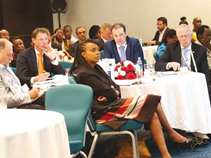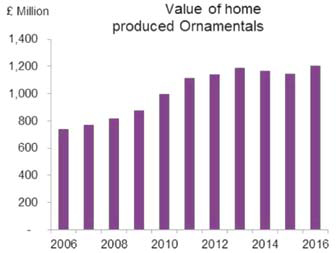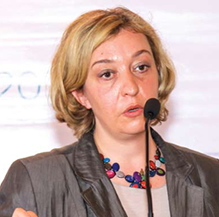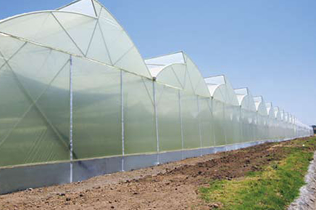Featured Past Articles
November 23, 2017: The second edition of Flower Logistics Africa 2017 had a full house representing a cross-section of the entire value chain of flower trade. Revolved around the core theme of “Enhancing Africa’s flower power through better logistics,” the event was held at the Radisson Blu Hotel in Nairobi and attracted participation from Africa and outside.
The participants of the day-long conference deliberated on the typical challenges faced by the flower industry as a whole. The discussions revolved around the need for standardisation that will enhance exports and gain traction for Kenya’s flower industry in the global market.
Read more: Standardisation in Flower Logistics a High Priority
 The second edition of the Flower Logistics Africa (FLA) and Perishable Logistics Africa (PLA) was held on the 22nd and 23rd November consecutively at the Radisson Blu Hotel in Nairobi. The event was organised by various stakeholders and went on successfully for the two days. The occasion brought together key industry players including growers, exporters, freight forwarders, the airlines etc.
The second edition of the Flower Logistics Africa (FLA) and Perishable Logistics Africa (PLA) was held on the 22nd and 23rd November consecutively at the Radisson Blu Hotel in Nairobi. The event was organised by various stakeholders and went on successfully for the two days. The occasion brought together key industry players including growers, exporters, freight forwarders, the airlines etc.
The conference was structured in to panel discussions where various panellists handled different topics as the audience actively participated in the discussions. The discussions on Flower logistics revolved on the theme: ‘Enhancing Africa’s flower power through better logistics’ and highlighted issues on technology trends in cool chain management, standards in packaging of flowers etc. while for the perishables was ‘Creating Africa’s future logistics grid for perishables’ and covered topics on industry collaboration, better logistics leads to profitability and reduces wastage, temperature management as well as transparency in transport from farm to fork. Logistics refers to the whole framework whether physical, technical or administrative for the transportation of perishables.
Read more: Enhancing Africa’s flower power through better logistics
UK ornamentals market up 4.7%
UK ornamentals were worth £1.2 billion in 2016, an increase of 4.7% compared to 2015, according to the latest horticulture statistics from the Department for Environment Food & Rural Affairs
.
The value of ornamental imports was just below £1.2 billion an 11% rise on 2015. The Netherlands accounted for 74% of imports, mainly indoor plants, chrysanthemums and roses. Kenya accounted for 5.8% of imports, mainly cut roses and carnations. Imports of cut flowers showed a 13% increase and bulbs a 6.4% increase
Initiate New Role Model of Trading Fair Poinsettias
 Since 2016, Selecta one supplies Fairtrade certified young plants to their poinsettia growers besides conventional ones. All poinsettias are sourced from Wagagai Ltd. in Uganda. Besides improving health and safety measures, enabling freedom of association and collective bargaining the employees benefit from a Fairtrade Premium, which can be used for social projects. Already in 2016, Selecta generated through their poinsettia sourcing at Wagagai a return of 8,000 Euro to local workers as a premium. Independently from this Selecta and Wagagai are fulfilling all environmental and social standards set by Fairtrade to meet the certification requirements.
Since 2016, Selecta one supplies Fairtrade certified young plants to their poinsettia growers besides conventional ones. All poinsettias are sourced from Wagagai Ltd. in Uganda. Besides improving health and safety measures, enabling freedom of association and collective bargaining the employees benefit from a Fairtrade Premium, which can be used for social projects. Already in 2016, Selecta generated through their poinsettia sourcing at Wagagai a return of 8,000 Euro to local workers as a premium. Independently from this Selecta and Wagagai are fulfilling all environmental and social standards set by Fairtrade to meet the certification requirements.
In Uganda as well as in other developing countries, basic wages in agriculture are well below what would be considered a living wage. Pay is insufficient to allow workers and their families meet their essential needs and afford them a decent standard of living. The absence of a minimum wage in Uganda compounds the problem. Besides that, wages cannot keep up with the rate of price increase. As a consequence people loose purchasing power. In addition many public services like schools are charged in developing countries. Often people do not have enough cash to send their children to secondary school.
Blooming opportunities & a stimulating outlook for the future
 The General Assemblyof Union Fleurs, the International Flower Trade Association, was organised this year in partnership with Flower Expo Poland in Warsaw, Poland.
The General Assemblyof Union Fleurs, the International Flower Trade Association, was organised this year in partnership with Flower Expo Poland in Warsaw, Poland.
Member stravelled from 11 countries as far as Turkey and Kenya to share perspectives and insights on the current developments in the floriculture value-chain. Overall, participants were impressed with the blooming business opportunities offered by the Polish market and the positive energy displayed at every corner of the joint fairgrounds of Flower Expo Poland and Green is Life.
During the Union Fleurs General Assembly meeting on 2nd September, members were joined by three knowledgeablestakeholders active in the Polish flower& plant sector: Mr Martijn Homan, Agricultural Counsellor at the Embassy of the Netherlands in Poland, Mr. Kees van Rijn, CEO of Polish-based Dutch wholesale company Bart Kwiaty and Ms. Anna Małcużyńska, director of PR agency Sigma International Poland, presented a very positive outlook on the future of the Polish marketwith solid growth perspectives in the coming years.They exchanged views with the participants onthe Polish market’s specificities, focusing on consumption & distribution patterns.
The meeting also offered stimulating views and perspectiveson the global challenges and market changes currently faced by the flowers& plants value-chain, particularly traders and wholesalers. The membership agreed that those pre-competitive challenges, including the Brexit process, market access issues and phytosanitary risks, require strategic and coordinated efforts through reinforced lobbying activities by Union Fleurs in Brussels and at international level, for the ultimate benefit of the global flower industry. Additionally, members supported ongoing initiatives to strengthen Union Fleurs activities in the pot plant segment and took on board the need to cooperate more actively among member countries to sustain and encourage global consumption of flowers & plants via generic promotion campaigns, in particular towards the younger generations.
In line with the Union Fleurs strategic review, devised in the last 3 years and formally approved in 2016, members widely supported there newed objective of further engaging directly with key private players of the floriculture value-chain, in addition to the traditional core membership of national wholesale & import/export trade associations. By directly connecting with Union Fleurs’ international network and supporting the Association’s missions and activities, those players will contribute to optimising the global enabling & policyenvironment of common relevance to all operators across the floriculture supplychain. This is more than ever one of the core missions and strategic objectives of Union Fleurs in order to deliver maximum value to its members as the international association of the flower trade.
A busy and stimulating agenda therefore lies ahead of Union Fleurs and its members in the coming months.
Union Fleurs would express its warmest thanks to the organisers of Flower Expo Poland & Green is Life and to the Embassy of the Netherlands in Poland, who had been of invaluable support to organise the General Assembly this year.
For further information, please contact: Sylvie Mamias Union Fleurs Secretary General Tel.: +32 2 736 79 97 Email: This email address is being protected from spambots. You need JavaScript enabled to view it.
Unique Style Connects with Growers
Product branding and Consistency:
“Agrichem Africa stand is designed well and everything is labelled and placed appropriately, visualized for audience and generation of credible messages about the products .This creates a unique sequence in its construction. All the banners, artworks, product labelling and the display racks are affixed on the more viewable places. What potential and existing customers see is arguably appropriate level of professionalism, said James Gacheru, Technical Manager Flower City Thika. when interviewed by The Floriculture Magazine Team.
Bigger exhibition Booth: “There’s a reason everyone wants to see the Grand Canyon: it’s really big! Similarly, one of the key factors in which exhibition attendees remember most is booth size” said James Gacheru, Technical Manager Flower City Thika. Agrichem Africa Ltd had bigger booth space; attractively designed, calling for attention and action from customers.
By John W. Bartok Jr.
The trend toward natural ventilation can eliminate the need for fans. If you have attended any of the industry product shows recently, you have seen new technology that will be part of your operation soon. There are many exciting developments that will make your job easier, reduce labor input and produce better plants.
Here are a few trends that I think will have an impact on your operations:
Internet information – The use of the internet is increasing rapidly. Information on what products are available, how to select the right one and how to install and maintain them is becoming readily available on the web. Purchasing through the internet will continue to increase. Monitoring and controlling the greenhouse environment with internetcontrolled electronic devices is becoming standard practice.
 Greenhouse design – To reduce electricity costs, more greenhouses are being built or retrofitted with natural ventilation. To increase the effectiveness of natural ventilation, greenhouses are getting taller. This also allows room for multiple energy/shade screens and more space for hanging basket production.
Greenhouse design – To reduce electricity costs, more greenhouses are being built or retrofitted with natural ventilation. To increase the effectiveness of natural ventilation, greenhouses are getting taller. This also allows room for multiple energy/shade screens and more space for hanging basket production.
Natural gas and high-efficiency heaters reduce heating cost. With improvements and lower prices for photovoltaic systems, growers are installing systems to offset the increasing cost of electricity. Several research projects are currently investigating the incorporation of solar collectors into the glazing on the greenhouse.
Supplemental lighting – There is a strong trend to install more efficient LED and HID lighting. Several research projects are looking at the benefits and economics of better plant growth control and greater utilization of greenhouses during the winter.
Irrigation – Water is become a regulated resource in many areas. There have been many innovations and improvements in the way water is applied to grow plants. Recycling, improved application methods, new sensors and controllers are available. These need to be put into use by growers, both large and small.
Environment controls – Great strides have been made over the past few years in integrating the equipment that controls the greenhouse environment. Both controllers and computers are readily available today. A trend toward using electronic controls by the smaller grower is developing. Besides saving energy, better plant quality and a shorter growing season can result.
Mechanization – Labor input for many crops is being reduced with new equipment. A trend toward once-through production is starting to develop. Equipment for spacing plants and plug sticking are the latest equipment developments. With labor being the greatest cost in the production of most plants and availability limited in many sections of the country, greenhouse operations will be designed to be more labor-efficient, utilizing mechanization.
Management – With the increase in mechanization and controls, there will be a greater need for people trained to select and maintain this technology. Engineers and technical service personnel will become part of many larger operations. Consultants are now available from suppliers to help growers.
There are still many challenges and opportunities in the greenhouse industry. Based on technology changes that have taken place in the last 50 years, it may be difficult to recognize the way greenhouse operations will look in the next 50 years. If a business is to succeed, it will have to select and install the technology that best fits these trends.
John is an agricultural engineer, an emeritus extension professor at the University of Connecticut and a regular contributor to Greenhouse Management. He is an author, consultant and certified technical service provider doing greenhouse energy audits for USDA grant programs in New England. This email address is being protected from spambots. You need JavaScript enabled to view it.


